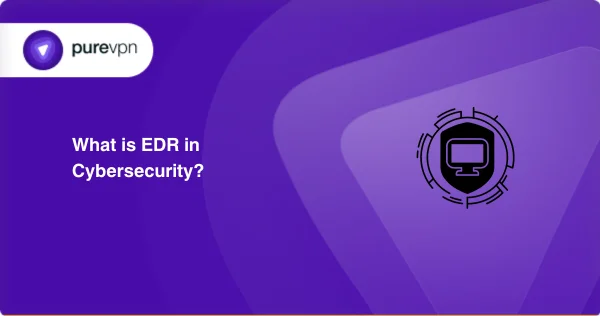Table of Contents
Endpoint detection and response systems allow security teams to locate suspicious activity on their endpoints to quickly cut off threats and limit possible damage from an attack.
Endpoint detection and response (EDR) is used to inspect endpoint threats. Such tools offer detection, investigation, threat hunting, and response capabilities.
Endpoint detection and response (EDR) has become an essential piece of any endpoint security solution.
There is no better way to detect intrusions than by sitting on the target environment being attacked, and the telemetry collected by an EDR platform can provide complete triage and investigation. In this article, we will talk about EDR technology in detail.

How EDR Works
Analyzing events from laptops, desktop PCs, mobile devices, servers, and even IoT and cloud workloads allows EDR security solutions to detect suspicious activity. These alerts enable security operations analysts to discover, investigate, and fix problems.
EDR tools also capture telemetry data on suspicious activity and may augment that information with other contextual information from correlated events.
With these capabilities, EDR brings down response times for incident response teams. Its aim is ultimately to preempt threats and prevent damage from occurring in the first place.
Endpoint detection and response were developed only in 2013. Over time, it grew in scope and now commonly provides antivirus or endpoint protection.
Importance of EDR Security
With remote work on the rise, good endpoint security has become essential to any organization’s cybersecurity strategy. But for both enterprise and remote workers, deploying an effective EDR security solution is critical to guard against cyber threats.
In this way, EDR supplements detection-based, reactive cyber defense. Rather than doing so, it gives security analysts the means to seek out threats and defend the organization actively. EDR provides several features that improve the organization’s ability to manage cybersecurity risk, such as:
Improved Visibility
EDR security solutions perform ongoing collection and analysis of the data, with all results sent to a single, centralized system. It allows a security team to have complete transparency into the state of the network’s endpoints.
Rapid Investigations
EDR solutions are aimed at automating data collection and processing and some response activities.
This allows a security team to quickly determine the context of a possible security event and take practical steps toward remediation.
Remediation Automation
EDR solutions can automatically carry out part of the steps in incident response according to preset rules. This allows them to handle blocking or quickly repairing incidents and lightens the load of security analysts.
Contextualized Threat Hunting
They continuously collect and analyze data, providing deep insight into an endpoint’s status. This way, threat hunters can look for evidence of a current infection.
EDR & EPP
EDR and EPP share the same objective but are designed to serve different functions. EPP is designed to offer device-level protection. It identifies malicious files, detects suspicious activity, and provides incident investigation and response tools.
EPP complements proactive EDR as a preventative measure. EPP serves as a first line of defense and drops threats that the organization’s deployed security solutions can detect.
EDR provides a second line of defense, allowing security analysts to carry out threat hunting and find more subtle threats aimed at the endpoint.
A comprehensive endpoint defense solution must have all the capabilities of EDR and EPP to stop cyber threats without overtaxing an organization’s already-stretched security team.
XDR – New Model of EDR
Traditional EDR systems only detect local endpoint events, providing insufficient visibility toward possible invasion. This leads to missed detections, more false positives, and longer investigating times.
XDR, or extended detection and response, is a new endpoint threat detection and response model. “X” means extended, but it refers to any data source, including network, cloud, or endpoint data.
XDR systems draw from heuristics, analytics, modeling, and automation to integrate and derive insight from these feeds, exceeding the visibility and productivity of siloed security tools.
Ultimately, this leads to more refined probes within security operations, so the time required to find, chase down, and respond to any threat is shortened.
What Should You Look For in an Endpoint Detection and Response Solution?
Here are some key aspects you should consider while buying an EDR solution.
Advanced Detection Capabilities
All the EDR solutions come with specific threat detection capabilities, but not all are up to the mark. When looking for an EDR solution, use the most advanced threat detection tools, including behavioral analysis, the ability to detect if the threats are known or unknown.
Your EDR solution should be able to detect a broad range of threats ranging from minor viruses to highly sophisticated malware.
Intelligence and Insight
When choosing an EDR solution, look for one that can easily integrate with additional security tools. This way, the overall security system of your network can be enhanced.
Integration of EDR with firewalls, SIEM systems, or threat intelligence teams level up the insight of the solution and makes it capable enough to fight against security threats effectively.
Quick Response and Mitigation System
Now, every EDR system has a detection and response system for malicious attacks. However, not all of them have impressive response rates.
Your EDR solution should be able to respond as quickly against the threat as possible. It shouldn’t wait until the danger has entered the system. Instead, its tools should enable it to take quick action before the danger has stepped inside the system.
It should also be able to mitigate the threat as soon as possible by taking quick action against it. There shouldn’t be any delay in the process at all.
Convenient User Interface
For effective security management, it’s essential that the EDR solution you choose is easy to use and has an uncomplicated user interface.
This will keep the security team safe from the hassle of being constantly confused, and an intuitive dashboard will help them analyze and respond to incidents much more quickly than usual.
Elements of an EDR Solution
An EDR security solution, as its name implies, must be able to assist an organization with both detection of cyber threats and response on its endpoints.
To enable security analysts to effectively and proactively detect cyber threats, an EDR solution should have the following components:
Incident Triaging Flow
Still, security teams can often be swamped with alerts, many of which are false positives. A proper EDR must automate the filtering of possibly suspicious or malicious events so the security analyst can focus their investigation.
Threat Hunting
All security incidents are not blocked or detected by an organization’s security solutions. To allow security analysts to search actively for possible penetration, EDR must offer some help with threat-hunting activities.
Data Aggregation and Enrichment
Context is a critical factor in distinguishing between real threats and false positives. EDR security solutions should use as much data as possible to help judge the danger.
After you find the threat, a security analyst should be able to quickly shift to fixing the danger. This requires the following capabilities:
Integrated Response
The need to switch back and forth between contexts impairs an analyst’s ability to react rapidly and effectively to a security incident. After analysts have reviewed the evidence, they should be able to take immediate steps to guard against a security incident.
Multiple Response Options
An appropriate response to a cyber threat hinges on several factors. An EDR security solution should provide analysts with several response choices.
PureVPN For Extra Protection
Endpoint detection and response systems are excellent for keeping your organization’s information secure, but they may not be enough. If you want to elevate your privacy and security, we recommend you use PureVPN.
PureVPN is the most reliable and versatile option out there. It protects you from viruses and malware by building a tunnel to exchange data from your location to the destination server. The original data gets encrypted and travels through the tunnel to its final destination.
Furthermore, PureVPN has built-in ad-blocking features to block those intrusive and malicious advertisements.
Endpoint Detection and Response System is Ideal for Cybersecurity
Endpoint Detection and Response is a high tech tool in modern cybersecurity by giving organizations real-time visibility into potential security threats.
EDR solutions focus on monitoring and analyzing activities on endpoints, such as individual devices or servers, to detect and respond to malicious behavior.
This heightened level of visibility allows for early identification of cyber threats, which enables swift response and mitigation.
As cyber threats evolve in sophistication, EDR becomes instrumental in enhancing an organization’s overall security posture. In essence, EDR serves as a frontline defense, contributing significantly to the resilience of an organization’s cybersecurity infrastructure.
Ensure you go for the right EDR to have the perfect security for your organization. At the same time, remember the base-level security that comes with PureVPN.



